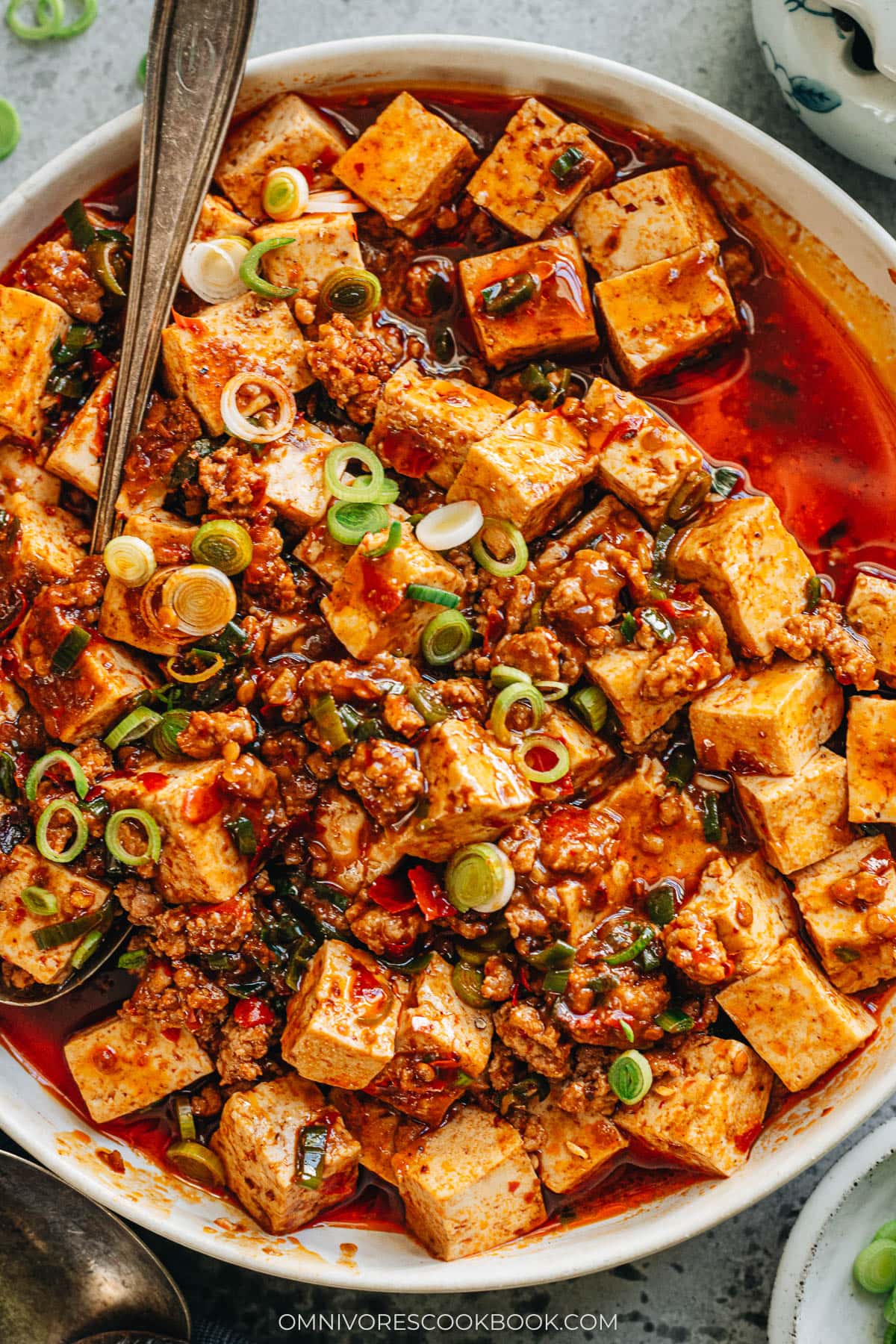
Mapo tofu (麻婆豆腐, ma po dou fu) is one of the most popular dishes from Sichuan cuisine. The tofu pieces are braised in a rich, spicy, savory sauce, along with fresh garlic and scallions. A small amount of ground pork enhances the flavor. The dish is so appetizing, and it goes perfectly with steamed rice.
Cooking mapo tofu is relatively easy, but you need a few special ingredients to get the authentic flavor. I’m sharing my favorite mapo tofu recipe below. It creates the very authentic taste that you’d get at a restaurant in China. However, you can easily tweak the dish according to your preferences.
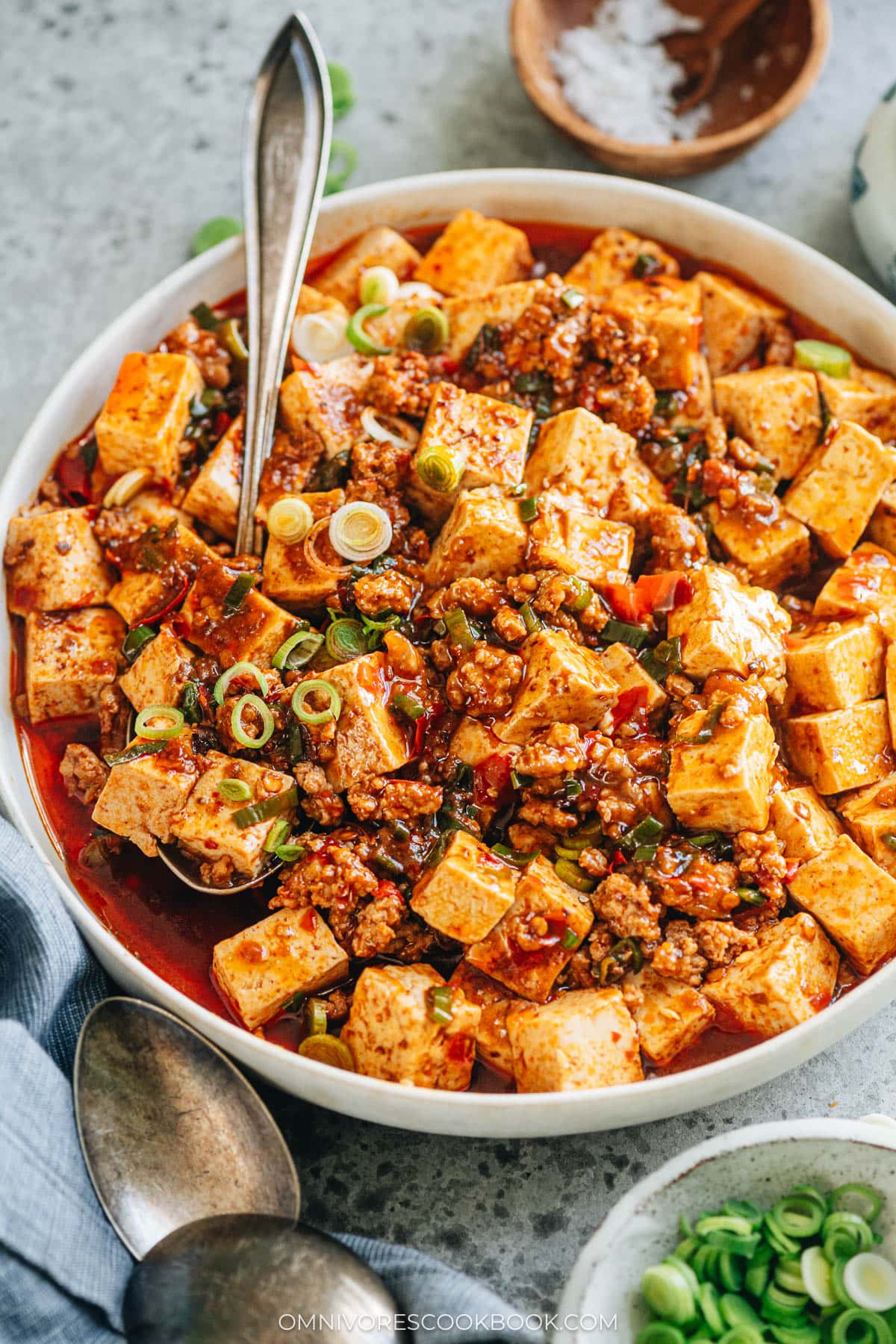
Key ingredients for Mapo Tofu
Doubanjiang
Doubanjiang (豆瓣酱), also known as spicy fermented bean paste, chili bean paste, chili bean sauce, or broad bean sauce, is the most crucial ingredient in mapo tofu. It has a strong, fermented, savory, salty, and spicy taste. Try to find “Pixian Broad Bean Paste” at your Asian market.Pixian is a small county in the Sichuan province that produces the best chili bean paste. If you’re using this brand, you’re already halfway there. You can also purchase this brand on Amazon here.
NOTE: The salt and spice level can vary greatly depending on the Doubanjiang brand. This dish is designed to be served with rice, so it’s on the salty side. To make your dish less salty and spicy, reduce the amount of Doubanjiang to 2 tablespoons.
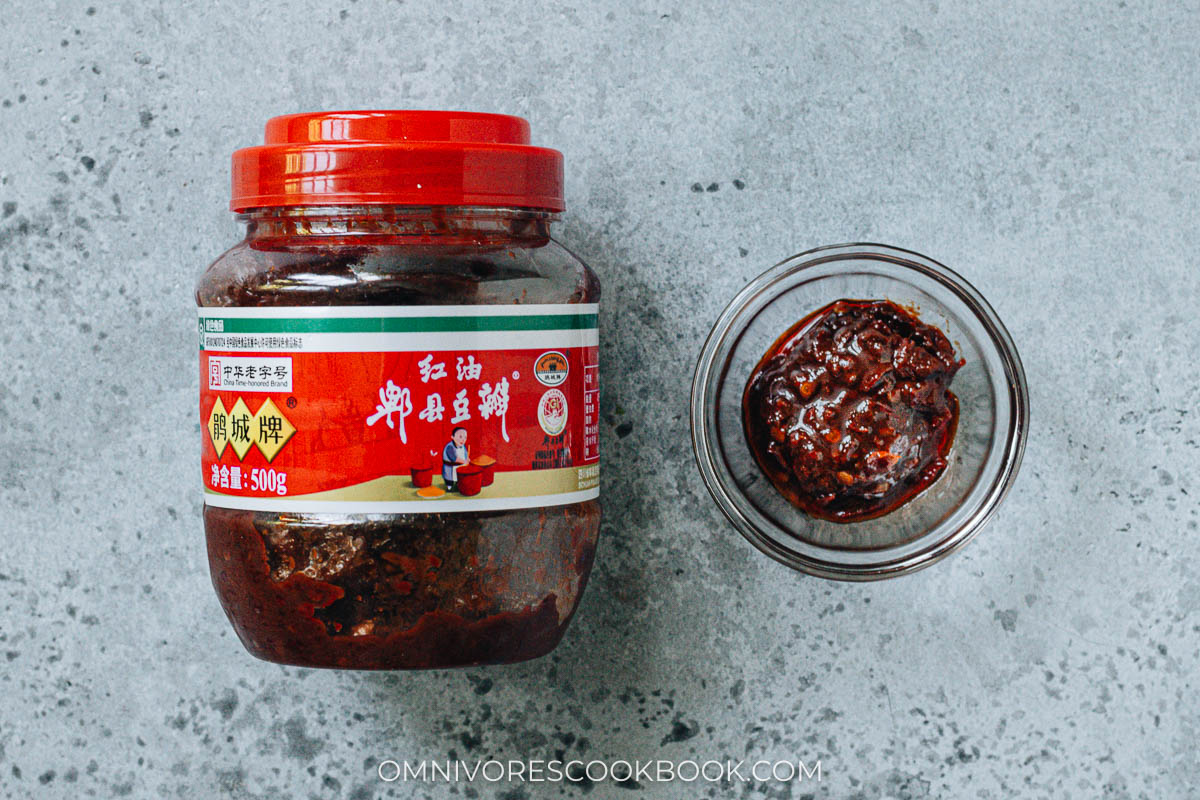
Sichuan peppercorns
Sichuan peppercorn (花椒, hua jiao) is another main ingredient in any Sichuan dish. It has a citrusy taste with a numbing tingling sensation when you chew on it. It’s a crucial and irreplaceable flavor-enhancing ingredient.. You can purchase Sichuan peppercorns at Asian grocery stores, but I highly recommend these premium fresh ones from The Mala Market.
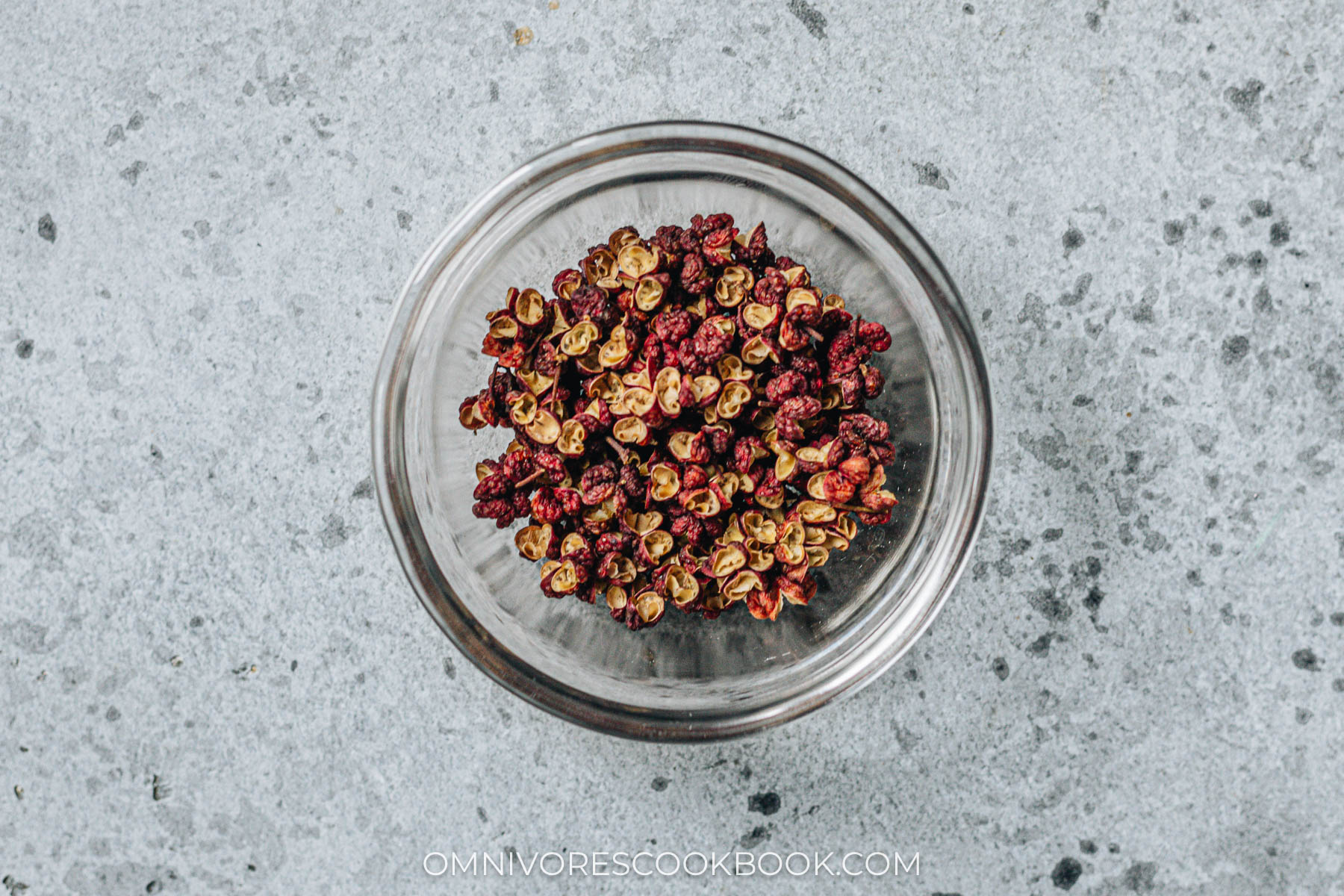
Sichuan peppercorn cooking tips
The most common way to cook Sichuan peppercorns is to fry them in hot oil. Doing so infuses the flavor and makes the dish milder. You can also grind the peppercorns and use them to garnish your dish later.
Alternatively, you can use ground-up fresh Sichuan pepper. I recently got a Sichuan peppercorn grinder from The Mala Market. I love that it’s fast and easy to use. Grind a small amount and add it when cooking or at the end to add flavor. If you have this product on hand, add 1/4 teaspoon ground Sichuan pepper when you add the ground pork.
When you use super fresh Sichuan pepper, the flavor is pungent. You may only need about half of the amount indicated in this recipe. The longer you store the peppercorns, the less fragrance they will have, and the more you need to use.
Homemade chili oil
The other essential ingredient is homemade chili oil (辣椒油). Freshly cooked chili oil tastes much better than store-bought and is free of additives. It only takes a few minutes to cook, and it’s really easy.
If you want to purchase chili oil, make sure to find a high quality one. And it should contains chili flakes and the oil, such as this one.
What to do with leftover chili oil?
You will usually cook more chili oil than you’ll use in one meal. You can store the extra oil in an airtight container in the fridge for 6 months to a year. Use it in various dishes, including Sichuan spicy wonton in red oil and Fu Qi Fei Pian (sliced beef in hot sauce). You can also add it to a dipping sauce for potstickers, to wonton soup to enhance the flavor, or even put it on oatmeal!
It might look like you need so many specialty ingredients for this one dish. But trust me, if you love Sichuan food, you’ll use them repeatedly.
How to cook mapo tofu
Fry the Sichuan peppercorns in the oil to infuse the aroma
- Fry the Sichuan peppercorns in the oil to infuse the aroma.
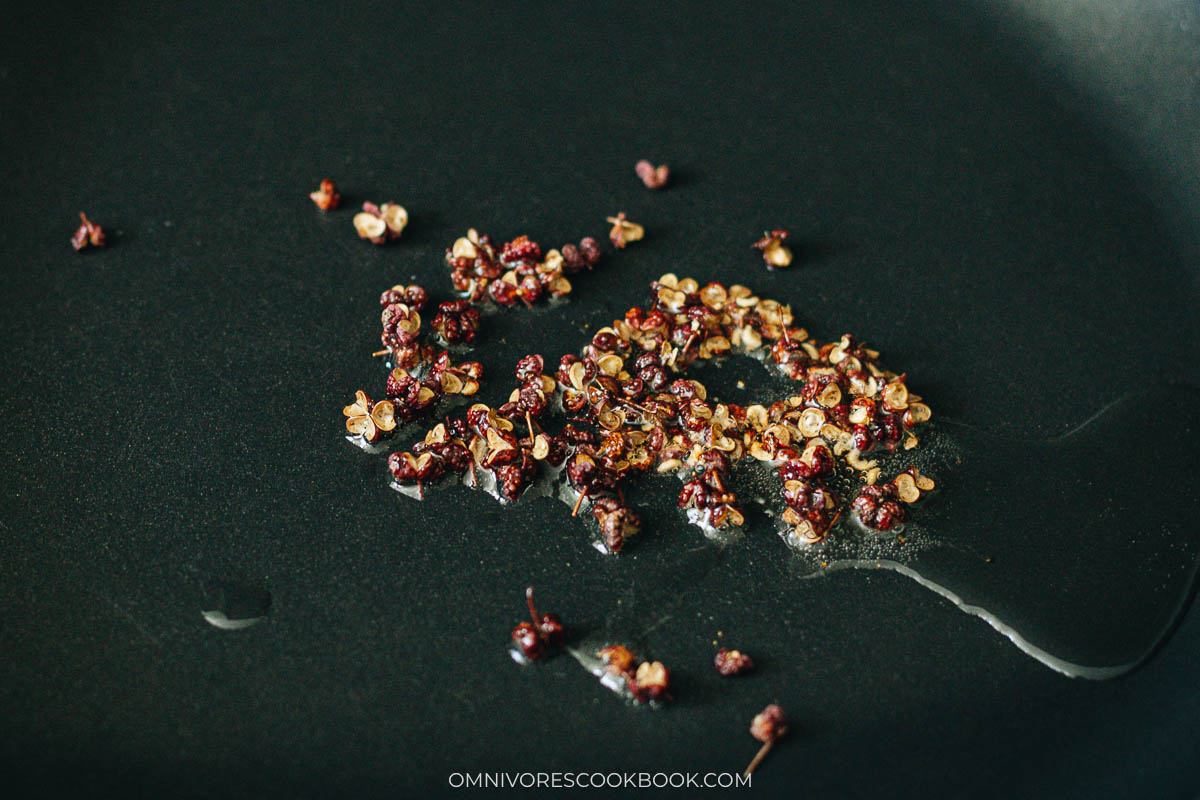
- Cook the ground pork with doubanjiang.
- Once the pork is cooked, add the green onions and stir a few times.
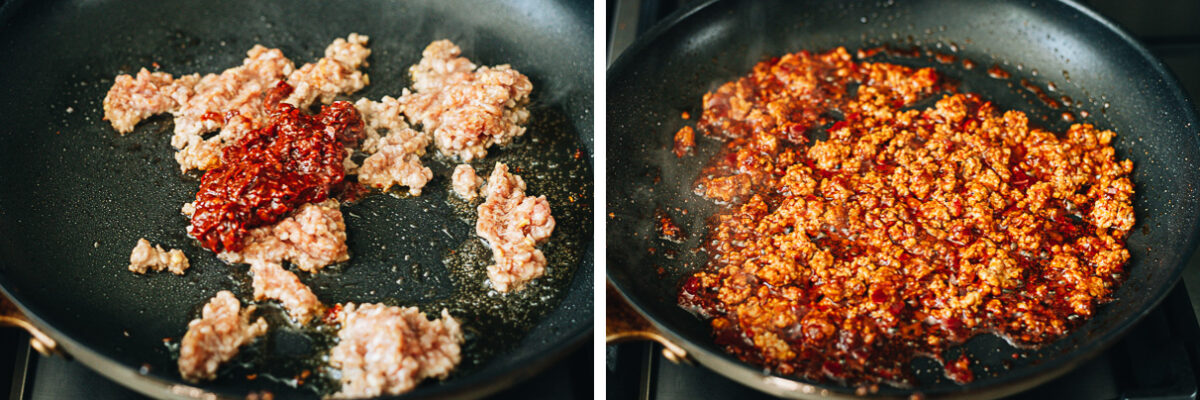
- Add the broth, tofu cubes, and braise with the cover on.
- Drizzle in the cornstarch mixture to thicken the sauce. Sprinkle with scallion greens for garnish.
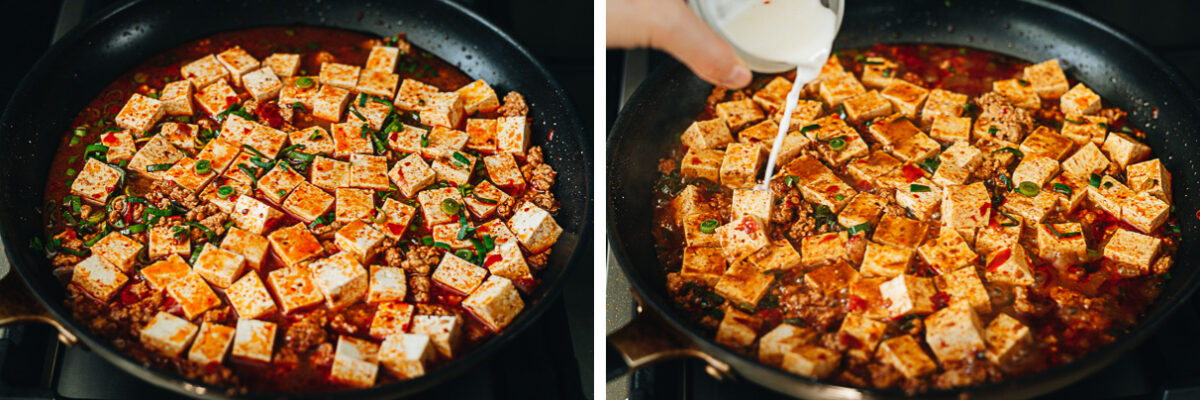
That’s it! I think this is one of the easiest Sichuan recipes, and the result is super rewarding 🙂
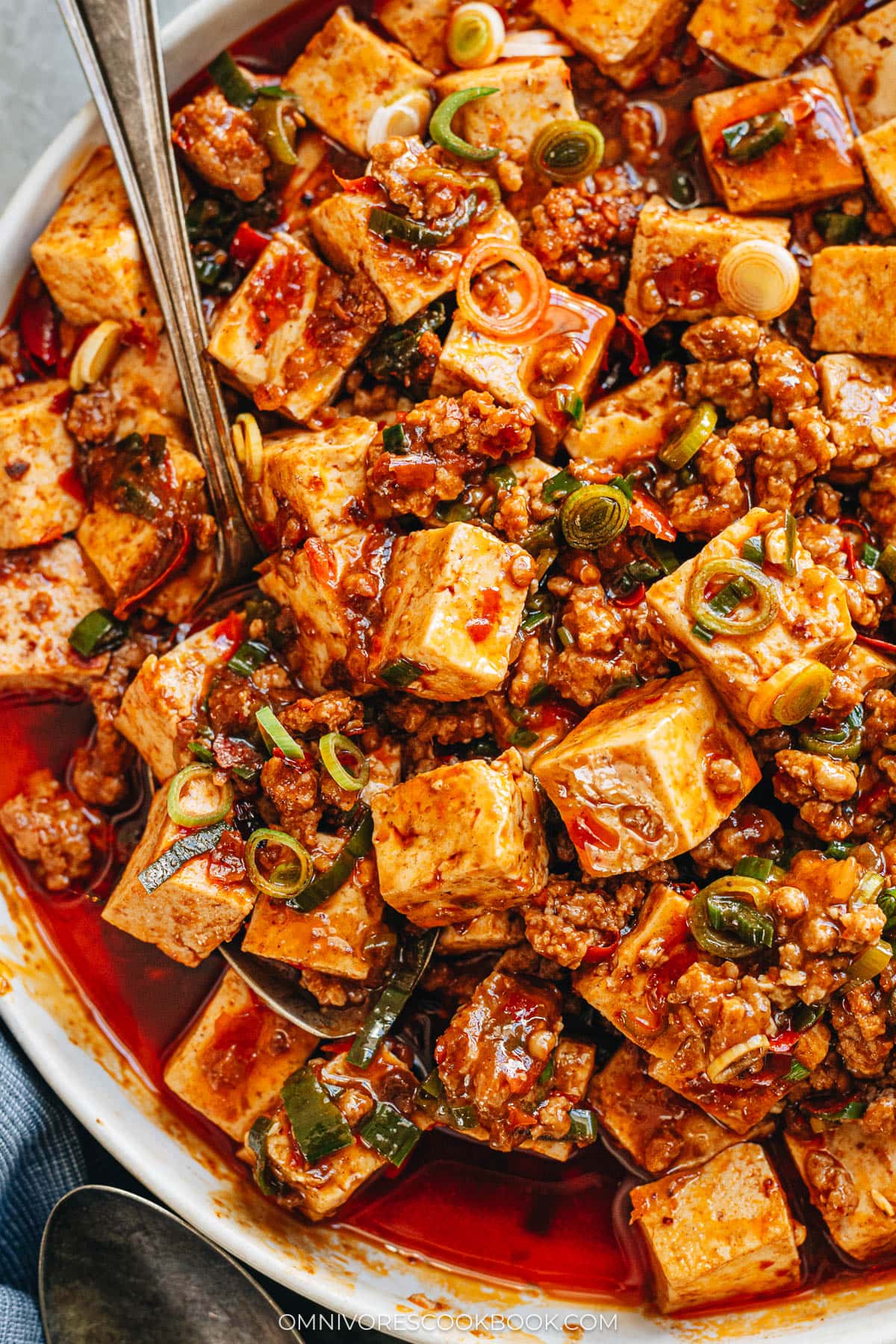
How to serve mapo tofu
I love cooking mapo tofu for a quick lunch or dinner and serving it over steamed rice. Sometimes I double the meat and sauce, so it will be enough to serve two people as a one-dish meal.
I also like to add a handful of greens (spinach, garlic chives, or other tender greens such as chopped up baby bok choy) at the end of braising before adding the cornstarch, to create a more nutritious and balanced meal. Sometimes I also replace the ground pork (used in the authentic version) with ground beef, or ground chicken, depending on what I have in the fridge.
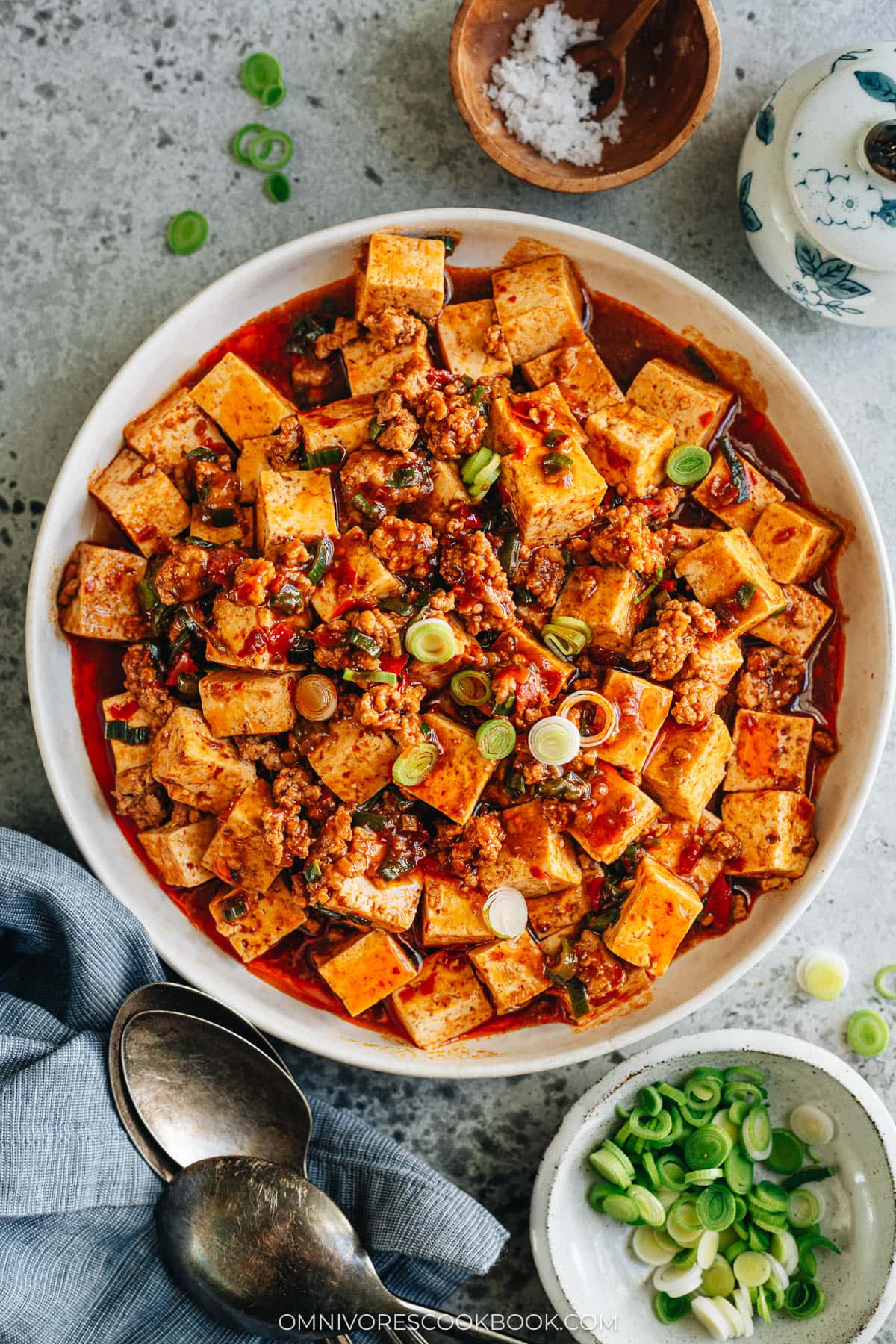
Frequently asked questions
What type of tofu should I use for mapo tofu?
There is no correct answer; you should choose what works best for you. Some Chinese restaurants, including many in China, prefer soft or silken tofu for a melt-in-your-mouth texture. This method requires some experience handling tofu, so you won’t break apart the delicate silken tofu while cutting and cooking.
This dish can also use extra firm, firm, or medium tofu, which is much easier to handle. Plus, once you braise the tofu in the rich, spicy sauce, it absorbs a lot of flavor and tastes great.
Do I need a wok to cook mapo tofu?
Not at all! I found it’s easiest to cook mapo tofu in a nonstick pan. The tofu will sit flat in the broth and absorb all the flavor. Plus, it won’t stick to the pan or fall apart when you stir it.
How do you make mapo tofu vegetarian or vegan?
I have a vegan mapo tofu recipe here that tastes super flavorful!
Chinese Cooking Made Easy
Are you new to this website? This free email series is a great place to start. I’ll walk you through a few of my most popular recipes and show you how and why they work. You’ll quickly start to cook better Chinese food in your own kitchen.
Watch video

Authentic Mapo Tofu (麻婆豆腐)
Ingredients
Marinating
- 4 oz ground pork (or chicken, or turkey) (*Footnote 1)
- 2 teaspoons Shaoxing wine (or dry sherry)
- 1 teaspoon light soy sauce
- 1/2 teaspoon minced ginger
For braising
- 1 teaspoon cornstarch (optional) (*Footnote 2)
- 2 teaspoons Sichuan peppercorns , increase to 3 teaspoons if you like your dish extra numbing, or reduce to 1 teaspoon if your Sichuan peppercorns are extra fresh
- 1 tablespoon peanut oil (or vegetable oil)
- 3 tablespoons Doubanjiang , reduce to 2 tablespoons for a less saltier and less spicy taste
- 2 green onion , chopped
- 1 block firm or medium firm tofu , cut into 1.5cm (1/2 inch) squares
- 1 cup chicken stock (or water)
- 2 teaspoons homemade chili oil (*Footnote 3)
- 1/4 teaspoon five-spice powder
- 1 teaspoon sugar (or to taste)
Instructions
- Combine ground meat, cooking wine, soy sauce, and ginger in a small bowl. Mix well.
- Combine cornstarch with 1 tablespoon of water in a small bowl. Mix well and set aside.
- Heat the oil and Sichuan peppercorns in a large nonstick skillet over medium-high heat. When the Sichuan peppercorns turn dark brown and crispy, scoop them out with a spatula and transfer into a bowl layered with paper towels to soak extra oil. Save to use for garnishing the dish (Optional).
- Add the ground meat and Doubanjiang. Cook over medium heat and chop the ground meat into small bits with a spatula, until pork is evenly coated with Doubanjiang and fully cooked through. Add green onion and stir fry for another minute.
- Spread tofu evenly on top of ground pork (*Footnote 4). Add chili oil, five-spice powder, and sugar. Pour in the broth and cook until brought to a simmer. Simmer, covered, over medium-low heat for 8 to 10 minutes, or until the sauce has reduced to half the original amount. Taste the tofu with some broth (be careful, it will be very hot!). Adjust seasoning by adding salt if needed. If the dish is too spicy, add another teaspoon of sugar to balance it out. Gently mix well with spatula.
- (Optional) Meanwhile, grind the fried Sichuan peppercorns (you used when heating up the oil) in a coffee grinder or using mortar and pestle.
- Mix cornstarch water again until fully dissolved and swirl it into the skillet. Gently stir a few times with a spatula, until sauce thickens. Turn off heat and transfer everything to a bowl.
- Garnish with extra green onion and a small pinch of the ground Sichuan peppercorns, if using (*Footnote 5), if using. Serve hot over steamed rice or by itself as main.
Notes
- You can skip the meat and make this dish vegetarian. In this case, I highly recommend replacing the meat with mushrooms (such as rehydrated dried shiitake mushrooms) to enhance flavor.
- If you like the tofu with more broth, you can braise the tofu for a shorter time and use the cornstarch slurry to thicken the broth. Alternatively, you can uncover and braise until most of the liquid evaporates. The tofu will absorb more flavor this way.
- You can also pour on more chili oil for the restaurant look!
- Do not stir the tofu immediately after adding it into the skillet, in order to keep the pieces from breaking apart. The tofu will get firmer after braising and you can stir it once it’s cooked.
- The Sichuan peppercorns add a numbing nutty aroma to the dish. The fried Sichuan peppercorns have a more rounded body so it works great for garnishing the dish or in a salad. You only need a small amount in this recipe to finish up the dish. Store the rest in an airtight container, no longer than a month.
Nutrition

Did you make this recipe?
I’d love to hear how it turned out for you! Please take a moment to leave a 5-star rating ⭐️ and share your thoughts in the comments further down the page. It really helps others discover the recipe too.

Kelly Bossert
This is an amazing dish. I’m making it again tonight but wondered if I could cut out the meat entirely? Would it have enough flavor and is there anything I could replace it with?
Maggie
Hi Kelly,
Yes you can cut out the meat. You can use a bit minced shiitake mushrooms to boost the taste, but I won’t worry too much if you cook without them. I also have a vegetarian mapo tofu recipe here: https://omnivorescookbook.com/vegetarian-mapo-tofu/
Happy cooking!
Kelly B
This is an amazing dish. I’m making it again tonight but wondered if I could cut out the meat entirely? Would it have enough flavor and is there anything I could replace it with?
Charles Wright
Wow, I followed your recipe. I did it for my girlfriend to eat. She liked it very much. Thank you so much .
Anthony Allen
That so so amazing. tofu looks delicious. so cravings! I love beef. I must try to do this dish tonight. Thanks for your recipe!!
Susan Dubose
I do love Mapo Tofu and will make your version soon. I didn’t know you could use beef too so will try it that way. Keep the good recipes coming, I am enjoying all of the ones I’ve tried.
Kula
Hello Maggie,greetings from Singapore!
I made this for dinner today and it was very good.
I did not have chilli oil so I just added 2 fresh chillis. I also added some button mushrooms (leftover in the fridge) to make it a more complete one dish meal.
Thanks for sharing! Looking forward to trying your other recipes.
O
Made this tonight with chicken and tofu. It’s abolitwly amazing, better than in any restaurant! Thank you so much for sharing this.
Kelly B
This was fantastic! I surprised my husband with this recipe today and he was silent (mouth full) for two big helpings lol! Thank you I will keep this in my repertoire along with some of your other fabulous dishes!
Savannah
Great recipe! I absolutely love Mapo-tofu. I was wondering, what’s the green vegetable side dish in the first picture? It looks delicious!
Thomas
Thanks, Savannah! The green veggie dish is the easy cucumber salad. It’s super simple and makes a great side for any Chinese meal 🙂
Kay
How much mushroom would you suggest I use to replace meat?
John
Ahh, yes. Very good. I feel like I’ve been looking for this recipe for a long time. Thank you!
Maggie
So glad to hear it John! Hope you have a great day and can’t wait to hear what you cook the next 🙂
Erika
Wow! Made this tonight and it was delicious! Flavors and seasoning were perfect!
Maggie
I’m so glad to hear it Erika! Happy new year 2018 🙂
Chit
Hi maggi am so happy and excited I stumbled upon your website! I did Mapo tofu today and you are right absolutely…the best! Been doing other recipes…now I have to delete them all in my recipe file! Thanks! And you are so pretty! I look forward to doing all in your cookbook! Thanks for that freebie!
Chit from the Philippines
J-Mom
My husband was hankering for mapo tofu. I knew I would find a great recipe at your website. We loved this. I really liked the flavor and kick of the Sichuan peppercorns. Thank you for the recipe !!!
Maggie
Big sorry if your inbox is bombarded with my replies J-Mom! I was traveling most of the weekends and just realized I haven’t reply my blog comments for weeks…
I’m glad that you like this version and do not mind the spiciness! It is one of our favorite winter dishes and it the perfect pair with rice 🙂
Lilian Cheng
Just made this and I wish I listened to the comments about it being too salty. Next time I’d cut the doubangjjang by half and avoid soy sauce and salt. I hate wasting food, but I had to throw half of it out. The other half I’m trying to salvage by adding more ground pork.
D.Friesen
Looks like a great recipe, and I’m going to try it tonight with one quite important addition: Sichuan peppercorn. When I lived in Chengdu I don’t think I ever had this dish without that Sichuan spice. Not sure how it can be called authentic without it.
Maggie
I totally agree with you on the Sichuan peppercorns. I usually add 2 teaspoons when heating up the oil to make the oil smoky and fragrant. When the Sichuan peppercorns turns dark brown, scoop them out and transfer to a small bowl with paper towel to soak extra oil. Once the dish is cooked, you can ground the sichuan peppercorns in a coffee grinder and sprinkle on the tofu. The freshly ground fried peppercorns have a more roundup flavor and nutty aroma.
Not sure why I skipped it when I published the recipe… Going to edit it right now.
dylan
ahhh this was sooo yummy and delicious! thank you 🙂 i’ve been using pre packed ma bo and finally decided i needed to make it myself 🙂
Tim
Is the doubanjiang really 3 tablespoons and not teaspoons? I’ve made it twice using no salt containing ingredients except the doubanjiang (no soy sauce or chicken bouillon) and have used both 2 and 3 tbsp. Both were too salty. :(. I see another recipe online that calls for only 2 teaspoons of doubanjiang (lady and pups).
Help!
Maggie
Hi Tim, I’m pretty sure I used 3 tablespoons when I was cooking this recipe, because it is the main ingredient. One of the reasons I can think of, probably I was using another brand of doubanjiang back then (I considered it common to find). I made sure I added enough so the dish won’t taste plain when serving with rice. I switched to the authentic brand now. From the ingredients of the recipe, I’d probably add 1 to 2 tablespoons (or 1 tablespoon plus extra homemade chili oil). I will need to test this recipe again so I can found out the correct measurement.
I’ve checked the recipe from Lady and Pups, it looks gorgeous! I like the idea of adding chicken stock into the stew.
Thanks for helping me troubleshooting the recipe Tim. I’ll make sure to revise and fix it.
Tim
Thank you so much, Maggie. I just found your blog and absolutely love your recipes. I lived in China for a little while and fell in love with the food but quickly became sad when I couldn’t find the same flavors back home – even at Chinese restaurants. I do think the key is the brand of doubanjiang because they all have different salt levels. I use the same brand as Lasy and Pups uses. I’m going to have to make this again tomorrow and use less doubanjiang but I really prefer to use more to get the flavor (but then the salt…). I guess I just need a less salty brand so I can use more of it. 🙂
Keep up the excellent work. You’re awesome!
Maggie
Hi Tim, always so happy to see a new reader who appreciates real Chinese flavor! 🙂 I agree with you, it is very difficult to find the authentic flavor outside of China. That’s the reason that I mostly cook Chinese food at home and seldom go trying out new restaurants these days.
As for the doubanjiang, you can try Lee Kum Kee. That’s the brand I used to cook with and it might be less saltier. But the Pixian one is supposed to be the real deal (the one you’re using now). One of the great way to add flavor is adding tons of homemade chili oil into the dish, like the recipe from Lady and Pups. If you’re cooking with my recipe again tomorrow, try 1 tablespoon doubanjiang and more chili oil (maybe use chicken stock instead of hot water). If you’re making chili oil with a less spicier type pepper (Korean chili pepper instead of Thai chili pepper), you can use quite a lot to add flavor without making the dish too salty.
Thanks for the kind words Tim! You just made my day 🙂
Alex
Late to the party, but i also thought that 3 tbsp of the pixian with low sodium chicken stock was too salty.
Checking the nutritonal facts, as far as salt content is concerned, 2 tbsp of pixian is about equal to 3 tbsp of lee kum kee.
I tried 1.5 tbsp with no sodium chicken stock, and though the result was a bit bland.
Im currently making this with 2 tbsp and no sodium chicken stock and have been happy with the results.
Just another data point for anyone browsing here.
Joyce
Thanks for such a delicious and easy recipe Maggie! I’ve tried another mapo tofu recipe that was not very successful, but when I saw your recipe, and how I already had all the ingredients at home, I decided to try making it again.
It was a HUGE hit with my husband, and it will be on my regular dinner rotation! 🙂 I also love reading about your Austin restaurant adventures – I live in Houston and travel to Austin a few times each year and enjoy reading about the new eats in town to check out. Keep up the good work!
Maggie
I’m so glad you tried my recipe and liked it Joyce! This is such a comforting dish that we cook it at home very often.
I didn’t realize we’re so close! We travel to Houston once in a while. It has a great collections of Asian restaurants and markets there, and I grab Shaoxing wine (the non-salted kind) there. I cannot find Shaoxing wine in Austin!
We cook at home most of the time, but we try to go to a new place every week or two. Will keep talking about it on the blog 🙂
Have a great week ahead!
CartoonGent
Thanks for the advice! I poked around a bit in the store and didn t see any Sichuan peppercorns that looked green and red like yours. The dried prickly ash all looked like dark brown balls. I was led astray by the spicy bean sauce because the jar had a picture of mapo tofu on it! I may try this dish again after learning from my mistakes. Thanks!
Xiaolu @6bittersweets
This looks wonderful, but you don’t seem to mention the chili oil again even though you say in the text that it’s needed for this recipe? Is there something missing from the recipe part?
Xiaolu @6bittersweets
Oops! My mistake — I see you listed it under sauce instead of oil in the ingredients. Can’t wait to try this!
Maggie
Hi Xiaolu, thank you for stopping by and I’m glad you like the recipe. 🙂
Yes, I used homemade chili sauce from another recipe instead of chili oil from supermarket. Although they are interchangeable, I like the homemade chili sauce better, because it’s fresh and have better flavor. Also it’s very easy to make and you can store it under room temperature for relatively long time – about 1 month.
Happy cooking and hope you enjoy the dish! 🙂
PR
Great recipe, excellent write up . Awesome taste!!
.